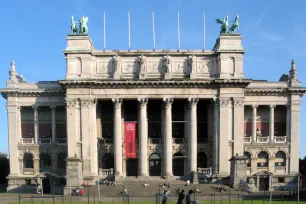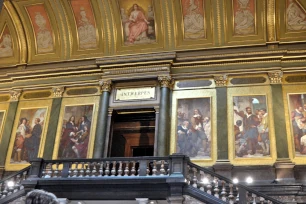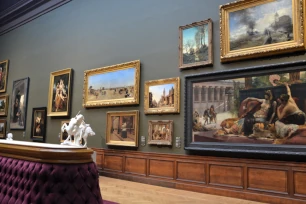Antwerp’s Royal Museum of Fine Arts is housed in a neoclassical temple that opened in 1890. Its collection contains paintings by numerous Flemish masters, including Antwerp’s most famous son Rubens, who had his workshop in this city.
A new location


From 1810 – the year of its founding by Napoleon – until 1875 the Royal Museum of Fine Arts was housed in the 15th-century Recollects Convent near the Stadswaag in the north of the city. After a fire in a nearby house spread to the convent and damaged the museum, it was decided to close the museum and look for a new location where its collection could be housed in a dedicated stand-alone building.
That same year a plan was approved to demolish an old citadel – built in the sixteenth century by the Spanish occupiers to keep the city under control – just south of the city center and develop it into a new neighborhood known as ‘t Zuid (Southside). The city council decided to build a new museum at a square in the middle of this new neighborhood.
In 1878 a national architectural competition was launched but after the first round it was decided that the museum was to be located in the middle of the square, rather than at the edge, so a new competition round was initiated. The winners of this competition were Frans Van Dijk and Jan Jacob Winders, who had earlier also won the competition for a large monument in the new neighborhood. Winders was responsible for the exterior of the building, while Van Dijk was in charge of the interior design and layout. Construction of the museum started in 1894 and it officially opened in 1890.
The building



The architects made several trips across central Europe and even got a personal tour by the architect of the then-under-construction Rijksmuseum to get inspiration for the new museum. Their choice for a classical Roman-Greek temple architecture is a reference to the cradle of Western culture. It is most notable at the front side of the sandstone building which is dominated by massive Corinthian columns. There are also Italian influences visible, such as the large loggia, where busts of artists are on display.
The architrave is decorated with statues of muses and medallions with relief busts of some of the artists whose work can be admired inside. Huge statues, created by local sculptors, decorate the sides of the massive building. The two bigas with the allegorical figure of ‘Fame’ that crown the top were created in 1905 by Thomas Vinçotte. They were made out of wood and finished with a copper layer.
Inside, an impressive vestibule with a double staircase leads to the museum’s largest room: the grand Rubens Room, which measures 29 meters in length, 12 meters in width and 15 meters in height (95 x 39 x 49 feet). The Van Dijck Room just behind it has similar dimensions, except that it is half as long. These two rooms form the heart of the museum and feature more gilded ornaments than any other room. The museum originally had four open patios, but those were later covered and have been integrated into the museum.
Museum Collection
The Royal Museum of Fine Arts displays a large collection of Flemish art, mainly paintings, covering an era that spans seven centuries, from the 14th century to the 20th century. It features a particularly large collection of the city’s most famous Baroque painters – Peter Paul Rubens, Anthony van Dyck, and Jacob Jordaens – but also boasts the world’s largest James Ensor collection. Foreign masters are also represented: there are works by Titian, Fra Angelico, Rembrandt van Rijn, Vincent van Gogh, Hans Holbein the Younger, and Edgar Degas among others.
Ground Floor
Expressionism


The ground floor is dedicated to modern art from the twentieth century. One of the main highlights is the room dedicated to James Ensor. Here you can admire «The Intrigue» (1890), one of Ensor’s most famous works. This expressionist work shows eleven masked figures, but the masks show the figures’ emotions rather than hide them. Other notable works by Ensor in this room include «The Oyster Eater» (1888) and «The Rooftops of Ostend» (1884).
Surrealism
Another well-represented Belgian artist from the 19th century who has gained worldwide fame is the surrealist painter René Magritte. His «Sixteenth of September», which he created in 1956, shows a tree with a crescent moon right in front of it instead of behind it.
The contemporary Belgian artist Paul Delvaux, who also liked to make forays in the surrealist genre, is best known for his dreamlike works of nude women, such as «The Pink Bows» from 1937, one of his key pieces.
Fauvism
The Fauvist artist Rik Wouters is represented with several works including «Woman Ironing» (1912), one of his most important works. It shows a domestic scene in which his wife and muse looks up while ironing. The bright colors that bring the work to life are characteristic for the artist’s oeuvre.
Latem School
The oeuvre of Constant Permeke on the other hand tends to be a lot darker. You can see his Vespers, which shows a farmer and his wife, scarred by their hard work, relaxing during afternoon prayers. Permeke belongs to the so-called Latem School, a group of Flemish expressionists. Other members whose works are on display on the ground floor include Gustave De Smet and Gustave Van De Woestyne.


Second Floor
Flemish Primitives
On the second floor you find older works of art, starting with the Flemish Primitives. One of the most important representatives is Jan van Eyck. Don’t miss his small chalk drawing of «Saint Barbara» (1437) on an oak panel. It isn’t clear if this work was a study, an underdrawing or a completed work but it gives an insight in the working methods of the old Master. Another famous Flemish artist from this era is Rogier van der Weyden, who is known for his triptychs, such as «The Seven Sacraments» (around 1440-1445), a work that shows scenes inside a Gothic church. It was meant to inspire and educate people about the sacraments. From the same era (around 1450) is the right panel of «Melun Diptych», a painting by the French court artists Jean Fouquet, which shows the «Virgin and Child surrounded by angels».
Antwerp School


It won’t be a surprise that the museum owns a sizable collection of works from the Antwerp School, which includes a number of well-known artists from the 16th century, Antwerp’s golden age. Quentin Matsys, who is considered the founder of the Antwerp School is naturally represented. His largest piece in the museum is the altarpiece for the Joiners’ Guild from 1511, which measures over five meters long. You can also admire a copy of «The Wedding Dance», originally by Pieter Bruegel the Elder, who settled in Antwerp in 1555 and is known for his depiction of rural life.
Baroque
The nucleus of the museum’s collection consists of its Baroque paintings and puts the spotlight on Antwerp’s most significant artists of the 17th century: Peter Paul Rubens, Anthony van Dyck and Jacob Jordaens. The museum’s collection of Rubens paintings is particularly impressive and fills the museum’s largest room. One of the masterworks on display is the «Adoration of the Magi» from 1624. Another famous work is «The Prodigal Son», from 1618.
Anthony van Dyck, who Rubens regarded as his best student, is also well represented. His most important work on display is «Lamentation of Christ», which he painted around 1640. A much more cheerful painting is Jacob Jordaens’s depiction of the old Dutch saying «As the Old Sing, So shall the Young Pipe» (1638).


Museum garden
There are few sculptures on display in the museum, but this is partly compensated for in the museum garden around the museum, known as Clara Peetershof. Here, the museum showcases about ten pieces of artwork from its collection. The garden’s layout loosely follows the geometrical pattern of the original garden that was created in the 19th century as an ornamental garden with parterres, but a thorough renovation in 2022 made it more accessible to visitors, who can now walk right up to the sculptures. The garden is named after Clara Peeters, a pioneer of still-life painting, who worked in Antwerp during the early seventeenth century. She is one of very few successful female artists from that era.
One of the highlights in the museum garden is «De Buildrager» (The Dock Worker), a statue created around 1885 by Constantin Meunier, a Belgian artist. Several copies were made of this work, but the one shown here is considered the original that Meunier first showcased in 1898. The statue portrays a laborer in the harbor of Antwerp who is responsible for manually loading and unloading ships.
On the east side of the museum, you can find a more recent monument, inaugurated in 2012. It stands at the site of a monument to Anthony Van Dyck that had stood here since 1899. It was replaced by two three-meter-tall statues of William of Orange – the leader of the Dutch revolt against the Spanish Habsburgs – and his right-hand man Philips of Marnix, Lord of Saint-Aldegonde. Seventeen columns represent the seventeen provinces that were part of the Habsburg Netherlands in the sixteenth century.
Deep Fountain

In front of the museum is a square dominated by a large water basin, measuring 34 meters long and 14 meters wide (112 x 46 feet). The basin is known as «Deep Fountain» and was created in 2006 by the Spanish artist Cristina Iglesias.
The bottom of the basin consists of resin in the shape of leaves, with an oxidized copper color. It is cut in two by a chasm through which water ebbs and flows every seven minutes due to an artificial tide. It is controlled by 18 sensors that monitor the status of the water and send the info to a central system.
- Next: Zurenborg
- More Sights & Attractions in Antwerp

